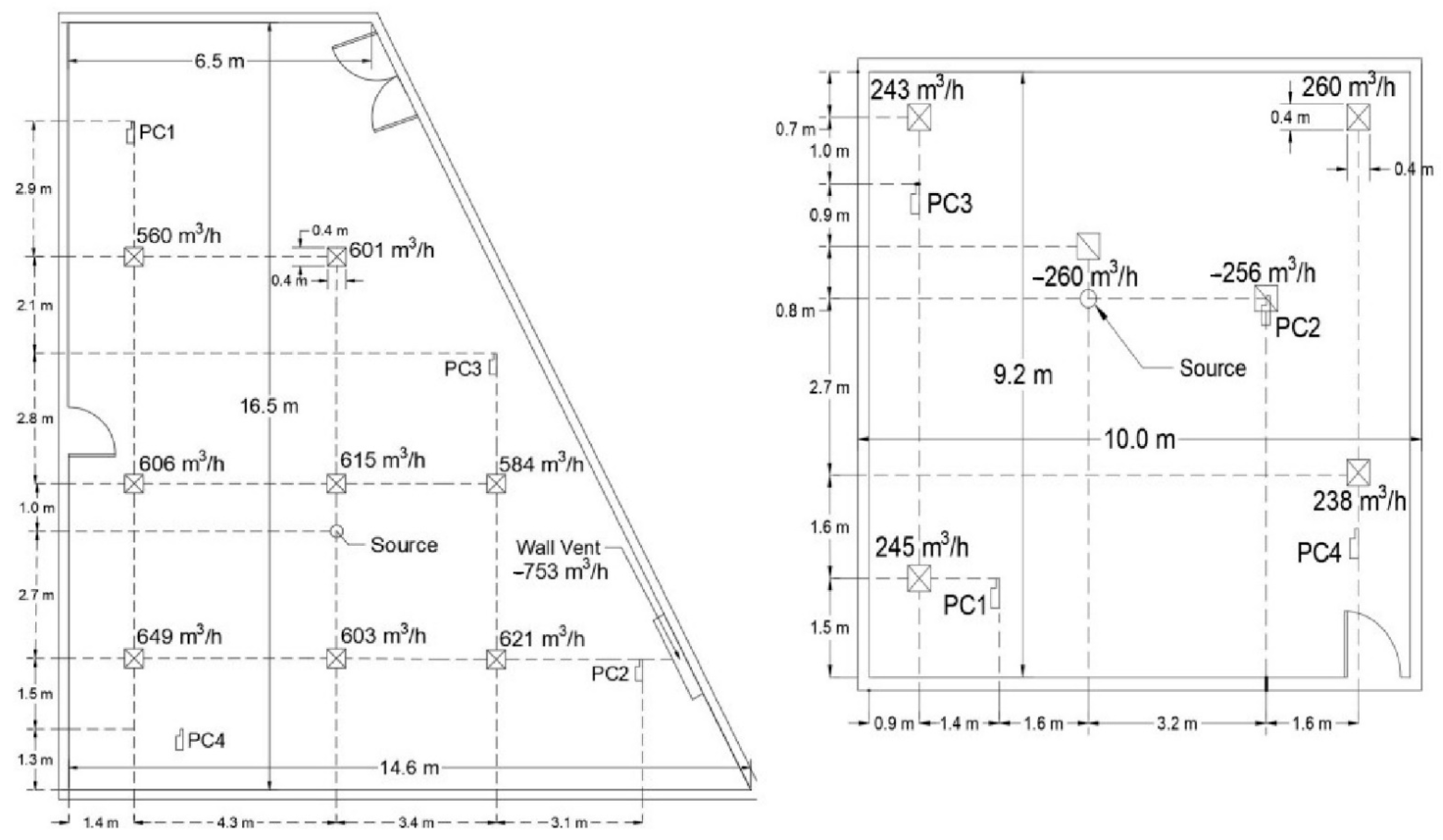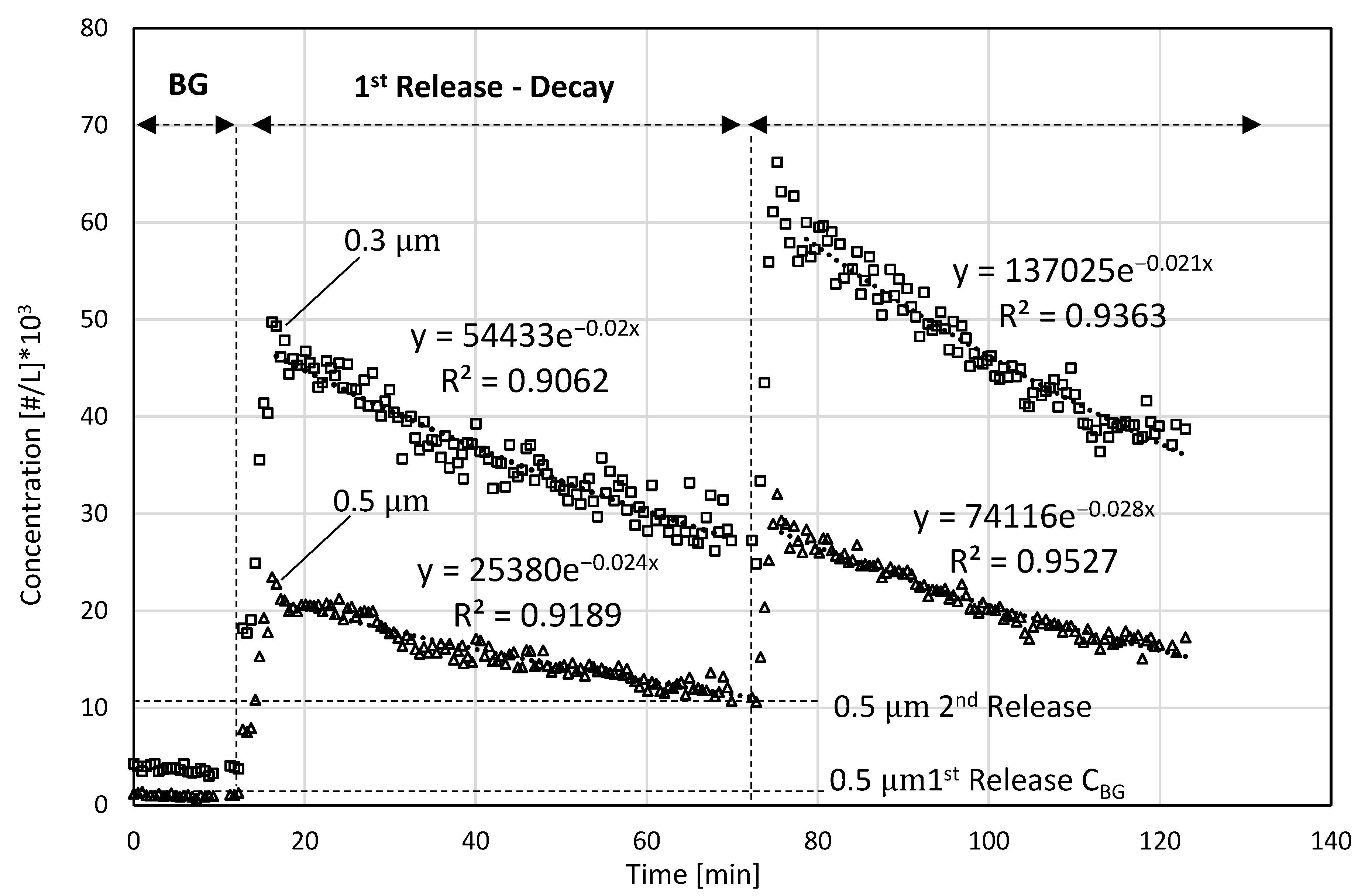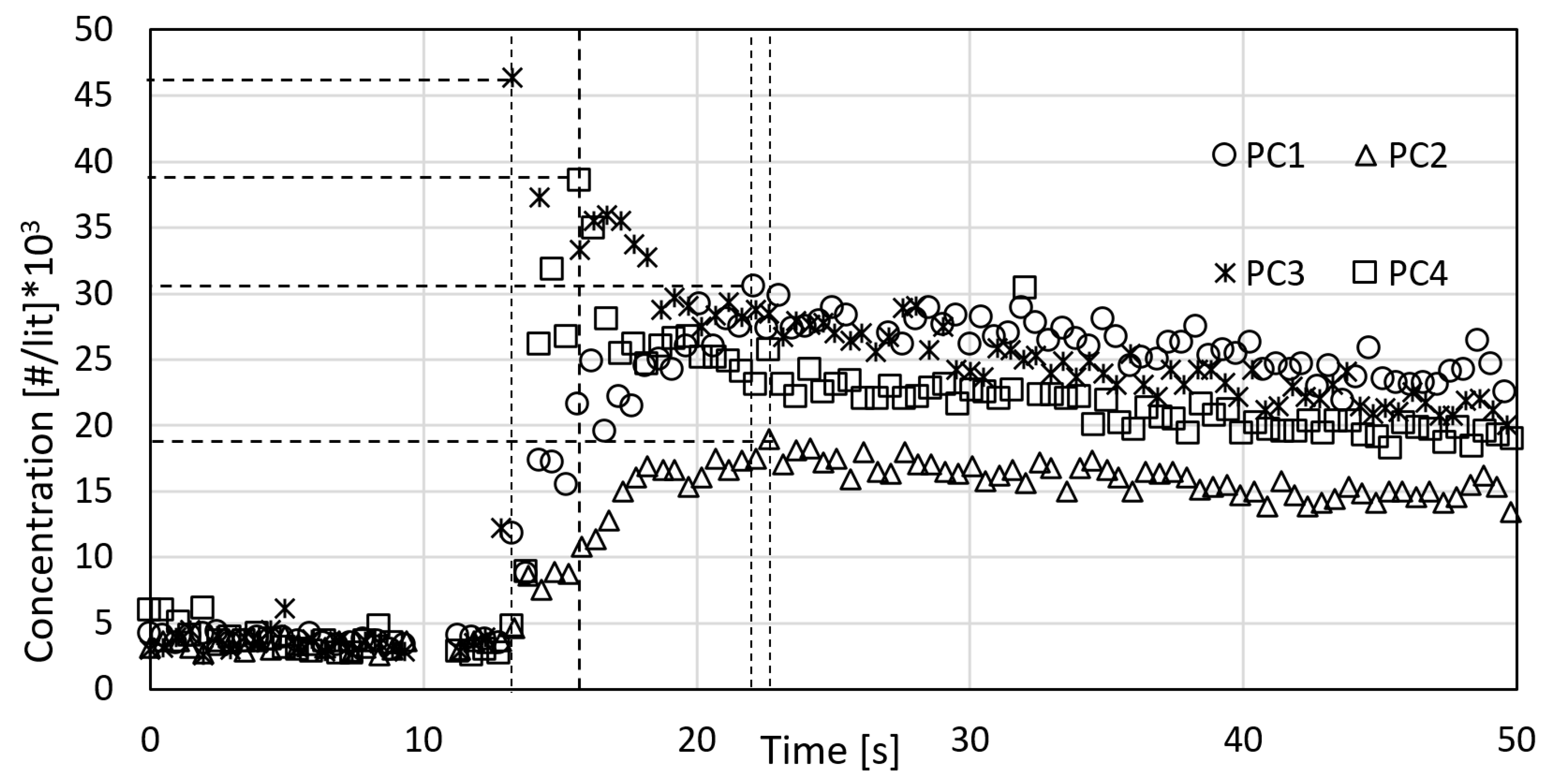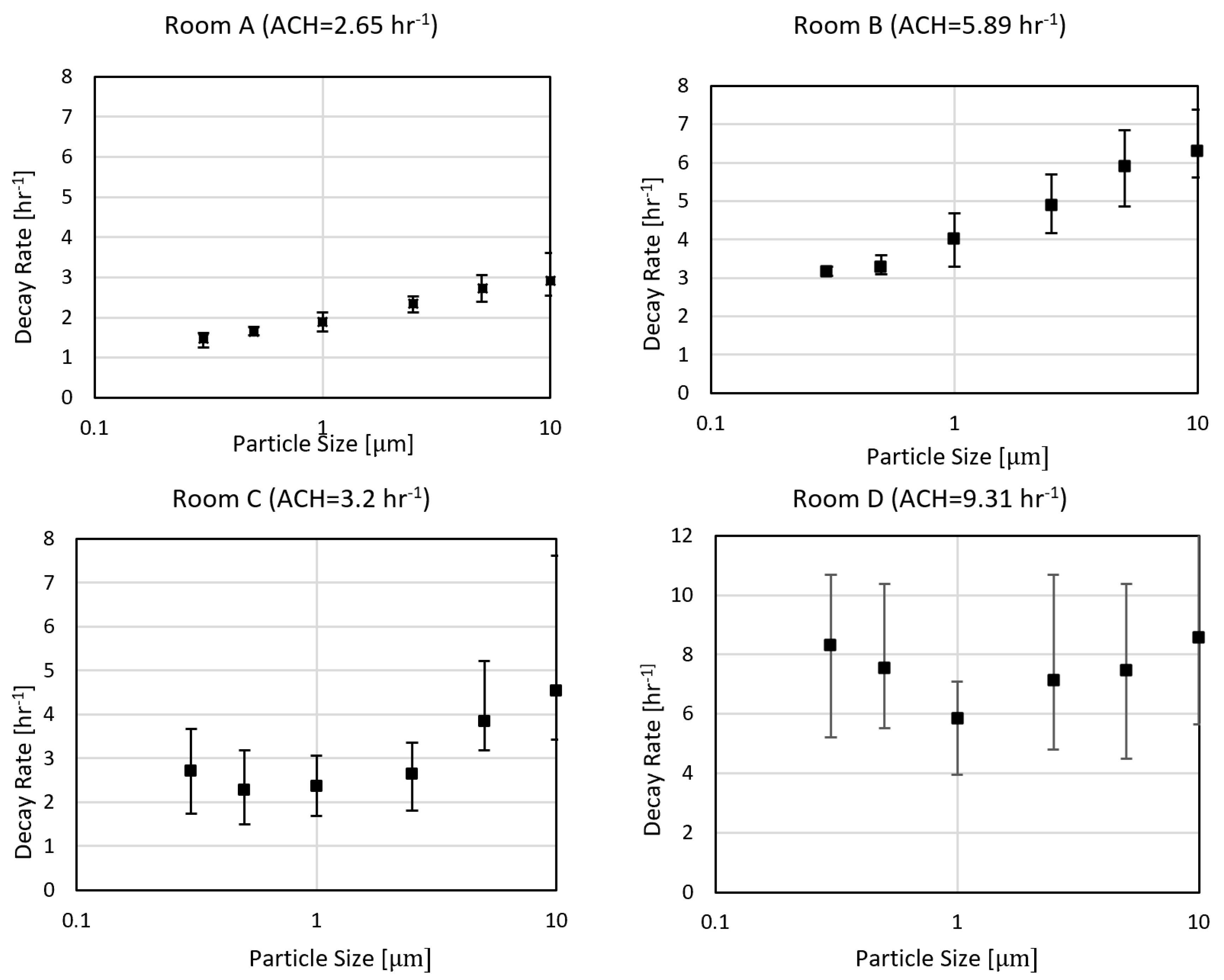Room HVAC Influences on the Removal of Airborne Particulate Matter: Implications for School Reopening during the COVID-19 Pandemic
Abstract
1. Introduction
2. Materials and Methods
2.1. Theoretical Background
2.2. Room Geometries and Ventilation Systems
2.2.1. Room A
2.2.2. Room B
2.2.3. Room C
2.2.4. Rooms D and E
2.3. Experiment Setup and Instrumentation
2.4. Statistical Analysis
3. Results and Discussions
4. Conclusions
Author Contributions
Funding
Institutional Review Board Statement
Informed Consent Statement
Data Availability Statement
Conflicts of Interest
References
- Zhang, S.; Ai, Z.; Lin, Z. Occupancy-aided ventilation for both airborne infection risk control and work productivity. Build. Environ. 2021, 188, 107506. [Google Scholar] [CrossRef] [PubMed]
- Kabrein, H.; Hariri, A.; Leman, A.M.; Noraini, N.M.R.; Yusof, M.Z.M.; Afandi, A. Impact of the air filtration on indoor particle concentration by using combination filters in offices building. I.O.P. Conf. Ser. Mater. Sci. Eng. 2017, 243, 012051. [Google Scholar] [CrossRef]
- Li, A.; Liu, Z.; Zhu, X.; Liu, Y.; Wang, Q. The effect of air-conditioning parameters and deposition dust on microbial growth in supply air ducts. Energy Build. 2010, 42, 449–454. [Google Scholar] [CrossRef]
- Liu, Z.; Deng, Y.; Ma, S.; He, B.J.; Cao, G. Dust accumulated fungi in air-conditioning system: Findings based on field and laboratory experiments. Build. Simul. 2021, 14, 793–811. [Google Scholar] [CrossRef] [PubMed]
- Cherrie, J.; Cherrie, M.; Davis, A.; Holmes, D.; Semple, S.; Steinle, S.; MacDonald, E.; Moore, G.; Loh, M. Contamination of air and surfaces in workplaces with SARS-CoV-2 virus: A systematic review. Ann. Work Expo. Health 2021, 65, 879–892. [Google Scholar] [CrossRef]
- Anderson, K.; Morris, G.; Kennedy, H.; Croall, J.; Michie, J.; Richradson, M.D.; Gibson, B. Aspergillosis in immunocompromised paediatric patients: Associations with building hygiene, design, and indoor air. Thorax 1996, 51, 256–261. [Google Scholar] [CrossRef] [PubMed][Green Version]
- Al-Harbi, M.; Alhajri, I.; Whalen, J.K. Characteristics and health risk assessment of heavy metal contamination from dust collected on household HVAC air filters. Chemosphere 2021, 277, 130276. [Google Scholar] [CrossRef]
- Santarpia, J.L.; Rivera, D.N.; Herrera, V.L.; Morwitzer, M.J.; Creager, H.M.; Santarpia, G.W.; Crown, K.K.; Brett-Major, D.M.; Schnaubelt, E.R.; Broadhurst, M.J.; et al. Aerosol and surface contamination of SARS-CoV-2 observed in quarantine and isolation care. Sci. Rep. 2020, 10, 12732. [Google Scholar] [CrossRef] [PubMed]
- Kenarkoohi, A.; Noorimotlagh, Z.; Falahi, S.; Amarloei, A.; Mirzaee, S.A.; Pakzad, I.; Bastani, E. Hospital indoor air quality monitoring for the detection of SARS-CoV-2 (COVID-19) virus. Sci. Total Environ. 2020, 748, 141324. [Google Scholar] [CrossRef]
- Astudillo, G.D.; Garza-Castanon, L.E.; Minchala Avila, L.I. Design and Evaluation of a Reliable Low-Cost Atmospheric Pollution Station in Urban Environment. IEEE Access 2020, 8, 51129–51144. [Google Scholar] [CrossRef]
- Jiang, H.; Xiao, H.; Song, H.; Liu, J.; Wang, T.; Cheng, H.; Wang, Z. A long-lasting winter haze episode in xiangyang, central china: Pollution characteristics, chemical composition, and health risk assessment. Aerosol Air Qual. Res. 2020, 20, 2859–2873. [Google Scholar] [CrossRef]
- Levy Zamora, M.; Xiong, F.; Gentner, D.; Kerkez, B.; Kohrman-Glaser, J.; Koehler, K. Field and Laboratory Evaluations of the Low-Cost Plantower Particulate Matter Sensor. Environ. Sci. Technol. 2019, 53, 838–849. [Google Scholar] [CrossRef]
- Qin, X.; Hou, L.; Gao, J.; Si, S. The evaluation and optimization of calibration methods for low-cost particulate matter sensors: Inter-comparison between fixed and mobile methods. Sci. Total Environ. 2020, 715, 136791. [Google Scholar] [CrossRef] [PubMed]
- Gao, J.; Zeng, L.; Wu, L.; Ding, X.; Zhang, X. Solution for sudden contamination transport through air duct system: Under a puff release. Build. Environ. 2016, 100, 19–27. [Google Scholar] [CrossRef]
- Scibor, M. Are we safe inside? Indoor air quality in relation to outdoor concentration of PM10 and PM2.5 and to characteristics of homes. Sustain. Cities Soc. 2019, 48, 101537. [Google Scholar] [CrossRef]
- Gonzalez-Brown, V.M.; Reno, J.; Lortz, H.; Fiorini, K.; Costantine, M.M. Operating Room Guide for Confirmed or Suspected COVID-19 Pregnant Patients Requiring Cesarean Delivery. Am. J. Perinatol. 2020, 37, 825–828. [Google Scholar] [CrossRef]
- Mousavi, E.S.; Grosskopf, K.R. Secondary exposure risks to patients in an airborne isolation room: Implications for anteroom design. Build. Environ. 2016, 104, 131–137. [Google Scholar] [CrossRef]
- Liu, Z.; Ma, S.; Cao, G.; Meng, C.; He, B.J. Distribution characteristics, growth, reproduction and transmission modes and control strategies for microbial contamination in HVAC systems: A literature review. Energy Build. 2018, 177, 77–95. [Google Scholar] [CrossRef]
- Ge, Z.Y.; Yang, L.M.; Xia, J.J.; Fu, X.H.; Zhang, Y.Z. Possible aerosol transmission of COVID-19 and special precautions in dentistry. J. Zhejiang Univ. Sci. B 2020, 21, 361–368. [Google Scholar] [CrossRef]
- McDonald, C.C. Reopening Schools in the Time of Pandemic: Look to the School Nurses. J. Sch. Nurs. 2020, 36, 239–240. [Google Scholar] [CrossRef]
- Levinson, M.; Cevik, M.; Lipsitch, M. Reopening Primary Schools during the Pandemic. N. Engl. J. Med. 2020, 383, 981–985. [Google Scholar] [CrossRef] [PubMed]
- Vermund, S.H.; Pitzer, V.E. Asymptomatic Transmission and the Infection Fatality Risk for COVID-19: Implications for School Reopening. Clin. Infect. Dis. 2020, 72, 1493–1496. [Google Scholar] [CrossRef] [PubMed]
- Viner, R.M.; Bonell, C.; Drake, L.; Jourdan, D.; Davies, N.; Baltag, V.; Jerrim, J.; Proimos, J.; Darzi, A. Reopening schools during the COVID-19 pandemic: Governments must balance the uncertainty and risks of reopening schools against the clear harms associated with prolonged closure. Arch. Dis. Child. 2021, 106, 111–113. [Google Scholar] [CrossRef]
- Center for Disease Control and Prevention Considerations for Schools Operating Schools during COVID-19; C.D.C.: Atlanta, GA, USA, 2020.
- Heating, Ventilation and Air-Conditioning Systems in the Context of COVID-19; European Centre for Disease Prevention and Control: Stockholm, Sweden, 2020.
- Faulkner, W.B.; Memarzadeh, F.; Riskowski, G.; Hamilton, K.; Chang, C.Z.; Chang, J.R. Particulate concentrations within a reduced-scale room operated atvarious air exchange rates. Build. Environ. 2013, 65, 71–80. [Google Scholar] [CrossRef]
- Noh, K.C.; Hwang, J. The effect of ventilation rate and filter performance on indoor particle concentration and fan power consumption in a residential housing unit. Indoor Built Environ. 2010, 19, 444–452. [Google Scholar] [CrossRef]
- Mousavi, E.S.; Kananizadeh, N.; Martinello, R.A.; Sherman, J.D. COVID-19 Outbreak and Hospital Air Quality: A Systematic Review of Evidence on Air Filtration and Recirculation. Environ. Sci. Technol. 2020, 55, 4134–4147. [Google Scholar] [CrossRef]
- Memarzadeh, F. The Environment of Care and Health Care Associated Infections–An Engineering Perspective; American Society for Health Care Engineering: Chicago, IL, USA, 2011. [Google Scholar]
- Mousavi, E.S.; Godri Pollitt, K.J.; Sherman, J.; Martinello, R.A. Performance analysis of portable HEPA filters and temporary plastic anterooms on the spread of surrogate coronavirus. Build. Environ. 2020, 183, 107186. [Google Scholar] [CrossRef] [PubMed]
- Azimi, P.; Stephens, B. HVAC filtration for controlling infectious airborne disease transmission in indoor environments: Predicting risk reductions and operational costs. Build. Environ. 2013, 70, 150–160. [Google Scholar] [CrossRef]
- Nazaroff, W.W. Indoor bioaerosol dynamics. Indoor Air 2016, 26, 61–78. [Google Scholar] [CrossRef]
- Nazaroff, W.W. Indoor Particle Dynamics. Indoor Air 2004, 14, 175–183. [Google Scholar] [CrossRef] [PubMed]
- Bhattacharya, A.; Metcalf, A.R.; Nafchi, A.M.; Mousavi, E.S. Particle dispersion in a cleanroom—Effects of pressurization, door opening and traffic flow. Build. Res. Inf. 2020, 49, 294–307. [Google Scholar] [CrossRef]
- Mousavi, E.; Mohammadi Nafchi, A.; DesJardins, J.; LeMatty, A.; Falconer, R.; Ashley, N.; Roth, B.; Moschella, P. Design and in-vitro testing of a portable patient isolation chamber for bedside aerosol containment and filtration. Build. Environ. 2021, 207, 108467. [Google Scholar] [CrossRef] [PubMed]
- Sun, C.; Zhai, Z. The efficacy of social distance and ventilation effectiveness in preventing COVID-19 transmission. Sustain. Cities Soc. 2020, 62, 102390. [Google Scholar] [CrossRef] [PubMed]











| Room Name | Room Ventilation Type | Room Size [m3] | Total Supply Recommended by ASHRAE 62.1 [m3/h] | Supply Flowrate [m3/h] | ACH [1/h] |
|---|---|---|---|---|---|
| A | Two fan coil units | 317 | 4600 | 840 | 2.65 |
| B | Central HVAC and three fan coil | 347 | 2555 | 2047 | 5.89 |
| C | Central HVAC | 402 | 2500 | 1292 | 3.22 |
| D | Central HVAC | 520 | 8500 | 4839 | 9.31 |
| E | Central HVAC | 268 | 10,100 | 986 | 3.68 |
| Make | Model | Measurement Type | Measurement Rate | Particle Size Range |
|---|---|---|---|---|
| EXTECH | VPC300 | Particles per intake (intake rate of 2.83 L/min) | 30 s | 0.3, 0.5, 1.0, 2.5, 5.0, 10 µm |
Publisher’s Note: MDPI stays neutral with regard to jurisdictional claims in published maps and institutional affiliations. |
© 2021 by the authors. Licensee MDPI, Basel, Switzerland. This article is an open access article distributed under the terms and conditions of the Creative Commons Attribution (CC BY) license (https://creativecommons.org/licenses/by/4.0/).
Share and Cite
Mohammadi Nafchi, A.; Blouin, V.; Kaye, N.; Metcalf, A.; Van Valkinburgh, K.; Mousavi, E. Room HVAC Influences on the Removal of Airborne Particulate Matter: Implications for School Reopening during the COVID-19 Pandemic. Energies 2021, 14, 7463. https://doi.org/10.3390/en14227463
Mohammadi Nafchi A, Blouin V, Kaye N, Metcalf A, Van Valkinburgh K, Mousavi E. Room HVAC Influences on the Removal of Airborne Particulate Matter: Implications for School Reopening during the COVID-19 Pandemic. Energies. 2021; 14(22):7463. https://doi.org/10.3390/en14227463
Chicago/Turabian StyleMohammadi Nafchi, Ali, Vincent Blouin, Nigel Kaye, Andrew Metcalf, Katie Van Valkinburgh, and Ehsan Mousavi. 2021. "Room HVAC Influences on the Removal of Airborne Particulate Matter: Implications for School Reopening during the COVID-19 Pandemic" Energies 14, no. 22: 7463. https://doi.org/10.3390/en14227463
APA StyleMohammadi Nafchi, A., Blouin, V., Kaye, N., Metcalf, A., Van Valkinburgh, K., & Mousavi, E. (2021). Room HVAC Influences on the Removal of Airborne Particulate Matter: Implications for School Reopening during the COVID-19 Pandemic. Energies, 14(22), 7463. https://doi.org/10.3390/en14227463







